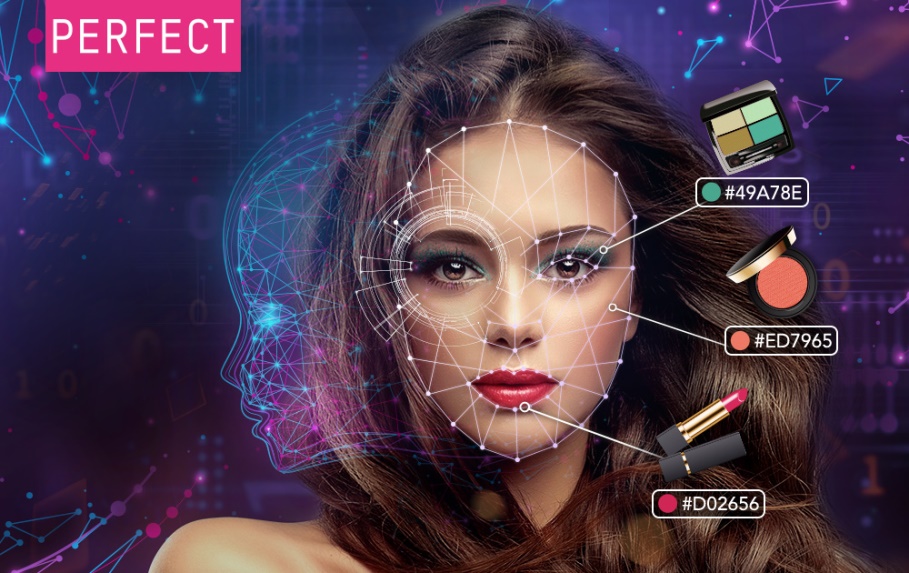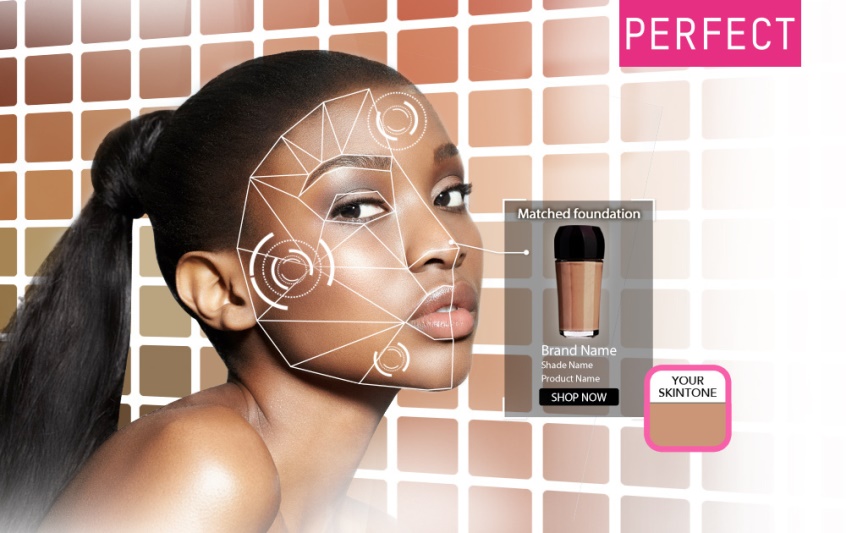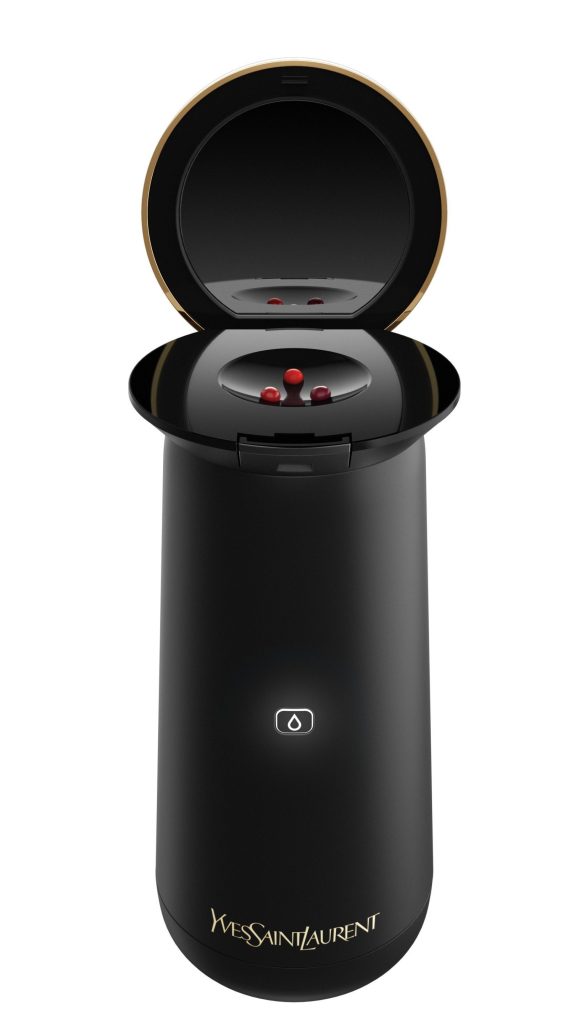虚拟试妆,对美妆行业而言是福是祸?

在迈入现代史之后的大部分时间里,人们购买美妆产品的方式一直都没有什么变化。
无论是为了要出席某项活动而购买一只新口红,还是要为冬季准备一支更保湿的唇膏,人们都会到访其最喜爱的商店,可能是某个繁华商业区的高档美妆专柜,也可能是就近的丝芙兰,亦或是便利店。
然而,随着21世纪00年代电商的崛起,人们似乎只需要轻松动动手指就能够买到美妆和护肤产品。
但人们很快发现,这种购物的灵活性是要以必要的购物体验为代价的。即便那些人们能够想到的所有化妆品几乎已尽数上线,但人们却无法再通过试用各种色调的粉底来找到最合适的那种颜色。同时,诸如向销售人员咨询哪款洗面奶最合适敏感皮肤的对话,也已经成为了一种遥远的记忆。
去年,这种美妆购物体验的失落感甚至变得更加明显,因为新冠疫情迫使全球大多数人居家隔离,与此同时,几乎所有的实体店都因此而歇业。
突然间,我们除了在线上购买美妆产品之外别无选择。即便在一些店面重新营业之后,受新的卫生与安全预防措施的影响,在购买前试用产品也被视为一种过时行为,而向销售人员征求意见又可能会传播或感染新冠病毒。
因此,有鉴于全球美妆行业营收预计将下滑20%至30%,而在线销售又远不能抵消实体店业绩的下跌,一些品牌开始启用两种长期以来一直在美妆行业边缘徘徊的科技:人工智能和增强现实。
多年来,数字创新一直在不动声色地改变着美妆行业,然而,体验过相关服务的消费者将大部分创新视为噱头、败笔或过于小众。
这一领域的早期参与者使用粗糙的虚拟现实功能,为用户提供化妆品虚拟试用服务。其前景在理论上令人振奋,但在实践中却是频频令人失望,而且缺乏可操作性。

转机出现在2014年,化妆品巨头欧莱雅推出一款在智能手机上使用的虚拟化妆镜Makeup Genius,这是增强现实技术在美妆行业的首次试水。
“这款应用程序在第一年的下载量超过了2000万,让我们的团队声名大振,同时也促使欧莱雅开始向人工智能数字服务迈进。”欧莱雅技术孵化器的全球副总裁基弗•巴洛克说:“技术孵化器部门认为,这类技术可能很快将在购物体验中随处可见,而且我们的首席执行官希望实现该技术的内部化,因此在当时,我们的首席数字官发起了对Modiface的收购。”
作为当时这一领域的领先技术,Modiface迅速成为了欧莱雅技术策略密不可分的一部分,而且在公司的诸多数字创新领域内发挥了重要作用。
然而,它也引发了巴洛克对一个新问题的关注。
“有时候产品种类不足,我们得去创造,但有时候产品种类又太多,我们得知道哪些产品适合自己。”他解释说。
由于客户在虚拟空间似乎拥有无限的产品可供试用,结果令很多用户感到不知所措,而且出现了购买倦怠情绪。
巴洛克说:“我们有必要帮助消费者找到适合的产品,因此我们开始使用人工智能技术。”
欧莱雅开发了一个可以测量肤色和皮肤状况的实体店工具,然后使用人工智能为客户创建个性化配方。
这项技术最先用于兰蔻的Le Teint Particulier粉底,随后延伸至修丽可的SkinScope。
新冠疫情及其催生的数字美容解决方案新需求在某种程度上让巴洛克及其团队吃了一颗定心丸,市场对其创新的需求可谓是如日中天。
他说:“这些技术让人们对美妆领域更加好奇,也提升了人们对这一行业的认知,有人很早便接受了这些技术并使用它,与它建立联系。”
“此外,我们还了解了人们在家中希望如何与产品进行互动的形式,因此我们加速了策略的实施,从而跟上整个世界的步伐。”
其中一个策略就是推出欧莱雅Perso智能系统,这个项目曾在数年前被搁浅,于去年重新被技术孵化中心启动。作为巴洛克所谓的“物质数字化”项目中的最新内容,Perso是一款实体设备,结合了人工智能和增强现实技术对其进行赋能。
上周,欧莱雅推出首款使用该技术的消费产品——圣罗兰 Rouge Sur Mesure。该产品使用圣罗兰标志性的Velvet Cream Matte Finish口红色彩配方,仅需一键便能够创造数千种定制色调。
在未来,欧莱雅计划为其旗下众多品牌打造类似基于Perso的设备,覆盖从奢华美妆线到药房护肤线的所有产品。

作为几家为数不多较早在这类技术研发上投入巨大精力和财力的公司,在2020年年初新冠疫情爆发后,当消费行为在一夜间发生改变时,欧莱雅处于明显的优势地位。
巴洛克说:“我认为欧莱雅策略了不起的地方在于,即便当时面临着重重挑战,公司依然对未来的愿景进行了投资,如今,我们有了这支杰出的团队。”
“在某种意义上,我认为我们所拥有的主要优势在于公司过去10年开发的基础设施,正因如此我们如今才能够完成那些具有一定复杂度的事情。”
其他一些品牌并不具有类似的数字创新历史,也没有必要的内部资源来满足市场对人工智能和增强现实技术服务不断增长的需求。
为了寻找解决方案,这些公司将目光瞄向了公司外部。随着近些年来消费者对此类技术的兴趣不断增长,品牌巨头、零售商和独立品牌都开始转向玩美移动公司。这是一家位于中国台湾的美容科技提供商,亦是人工智能和增强现实解决方案领域的先驱。
自2015年成立以来,公司已经利用增强现实技术、面部识别和颜色匹配打造了多项服务。而且事实证明,这些服务在美妆行业的数字化进程中发挥了不可估量的作用。
玩美移动公司的高级副总裁兼总经理Wayne Liu表示:“最初,公司的销售是有些困难的,因为当时的美妆行业非常传统,而且人们认为这种数字服务产品会有色差。然而,在向雅诗兰黛这类品牌进行概念验证展示之后,公司的产品引发了巨大的反响,雅诗兰黛成为了我们合作的第一家公司。”
2019年,雅诗兰黛采用了玩美移动公司的YouCam Makeup虚拟试用颜色匹配体验来打造iMatch Virtual Shade Expert,后者可以帮助客户找到雅诗兰黛持妆DW粉底液(Double Wear Stay-in-Place Makeup)以及沁水轻粉底液(Futurist Hydra Rescue Moisturizing Makeup)产品中最适合他们的色号,并能够看到相应的虚拟妆容。
在Shade Expert获得成功,并且人们意识到疫情期间相关数字美妆服务的巨大需求之后,雅诗兰黛于去年年底再一次与玩美移动合作,打造了iMatch Virtual Skin Analysis这款自助式数字护肤诊断工具,它采用了最新的YouCam人工智能技术,来揭示皮肤所需的个性化护理方案。
雅诗兰黛全球消费营销高级副总裁琼•罗曼说:“我们的目标是为客户提供最个性化、最生动的体验,这也是公司品牌的核心价值观。对人工智能技术的运用能够让我们提供精准的个性化产品推荐,同时让消费者获得同样的深入接触体验,而且不受购物场景空间的限制。”
个人护理和医疗巨头强生旗下的公司露得清在2020年年初也向玩美移动寻求帮助,来打造其最新版皮肤分析工具Skin360,这款应用程序此前曾经需要花60美元购买手机附件才可以使用。
玩美移动的YouCam技术让该应用程序直接使用智能手机镜头便可以提供180度的自拍分析,而由玩美移动公司和强生研发团队合作开发的算法则能够分析超过2000多种面部肤质的10万个皮肤像素点,并提供超过250万条可能的产品推荐。
自重新推出之后,Skin360应用程序斩获了11.5万次的下载量,露得清认为这一应用程序的大热得益于人们对居家专业级皮肤评估需求的攀升。
该品牌去年还与谷歌和YouTube合作,使用其新开发的Virtual Try On技术,让消费者在观看YouTube视频时,与他们最喜爱的美妆博主们一道试用露得清的唇彩。
公司目前正在与亚马逊的美妆试用技术合作。
然而,在密切关注疫情期间消费行为向线上转变的现象之后,露得清推出了自己的虚拟试用解决方案,它借助了玩美移动的YouCam Makeup技术,将于2021年第一季度面世。
露得清的痤疮创新与皮肤科技总监罗根•麦克吉尔称:“最终,随着线上购物的增长以及零售商出于卫生考虑而取消实体店面测试器,数字功能的进步将帮助人们把握市场机遇。”
“通过像露得清Skin360这类能够实现虚拟试用美妆产品的应用程序平台和技术,我们的目标是让消费者直接掌控自己的护肤权,让他们可以更多地了解自身的皮肤状况,并能更加便利地找到适合他们独特需求的产品。”
尽管基于人工智能和增强现实的美妆创新早在疫情之前便已面世,但疫情及其给化妆品行业带来的问题,毫无疑问加速了消费者对此类解决方案的采纳。
正因为如此,我们几乎可以肯定的是,对美妆科技的需求将在未来持续很长一段时间,即便传统的实体店购买体验回归常态之后亦是如此。
然而,化妆品行业的众多巨头并不相信实体店面在未来丝毫没有立足之地,而技术创新在实体店依然有所作为。
玩美移动的Wayne Liu解释说:“一方面,作为技术提供商,我们将提供客户所需的技术,以便消费者在家中也能得到实体店的购物体验。然而在另一方面,一些与我们合作的美容品牌的确还在依赖实体店,而且它们也确实需要让消费者回归实体店,并通过新的方法来实现这一点。因此,相关的店面技术便有了用武之地。”
他还指出,公司的重点已经不再是解决眼下的问题,而是开始着眼于未来的长远问题。(财富中文网)
译者:冯丰
审校:夏林
在迈入现代史之后的大部分时间里,人们购买美妆产品的方式一直都没有什么变化。
无论是为了要出席某项活动而购买一只新口红,还是要为冬季准备一支更保湿的唇膏,人们都会到访其最喜爱的商店,可能是某个繁华商业区的高档美妆专柜,也可能是就近的丝芙兰,亦或是便利店。
然而,随着21世纪00年代电商的崛起,人们似乎只需要轻松动动手指就能够买到美妆和护肤产品。
但人们很快发现,这种购物的灵活性是要以必要的购物体验为代价的。即便那些人们能够想到的所有化妆品几乎已尽数上线,但人们却无法再通过试用各种色调的粉底来找到最合适的那种颜色。同时,诸如向销售人员咨询哪款洗面奶最合适敏感皮肤的对话,也已经成为了一种遥远的记忆。
去年,这种美妆购物体验的失落感甚至变得更加明显,因为新冠疫情迫使全球大多数人居家隔离,与此同时,几乎所有的实体店都因此而歇业。
突然间,我们除了在线上购买美妆产品之外别无选择。即便在一些店面重新营业之后,受新的卫生与安全预防措施的影响,在购买前试用产品也被视为一种过时行为,而向销售人员征求意见又可能会传播或感染新冠病毒。
因此,有鉴于全球美妆行业营收预计将下滑20%至30%,而在线销售又远不能抵消实体店业绩的下跌,一些品牌开始启用两种长期以来一直在美妆行业边缘徘徊的科技:人工智能和增强现实。
多年来,数字创新一直在不动声色地改变着美妆行业,然而,体验过相关服务的消费者将大部分创新视为噱头、败笔或过于小众。
这一领域的早期参与者使用粗糙的虚拟现实功能,为用户提供化妆品虚拟试用服务。其前景在理论上令人振奋,但在实践中却是频频令人失望,而且缺乏可操作性。
转机出现在2014年,化妆品巨头欧莱雅推出一款在智能手机上使用的虚拟化妆镜Makeup Genius,这是增强现实技术在美妆行业的首次试水。
“这款应用程序在第一年的下载量超过了2000万,让我们的团队声名大振,同时也促使欧莱雅开始向人工智能数字服务迈进。”欧莱雅技术孵化器的全球副总裁基弗•巴洛克说:“技术孵化器部门认为,这类技术可能很快将在购物体验中随处可见,而且我们的首席执行官希望实现该技术的内部化,因此在当时,我们的首席数字官发起了对Modiface的收购。”
作为当时这一领域的领先技术,Modiface迅速成为了欧莱雅技术策略密不可分的一部分,而且在公司的诸多数字创新领域内发挥了重要作用。
然而,它也引发了巴洛克对一个新问题的关注。
“有时候产品种类不足,我们得去创造,但有时候产品种类又太多,我们得知道哪些产品适合自己。”他解释说。
由于客户在虚拟空间似乎拥有无限的产品可供试用,结果令很多用户感到不知所措,而且出现了购买倦怠情绪。
巴洛克说:“我们有必要帮助消费者找到适合的产品,因此我们开始使用人工智能技术。”
欧莱雅开发了一个可以测量肤色和皮肤状况的实体店工具,然后使用人工智能为客户创建个性化配方。
这项技术最先用于兰蔻的Le Teint Particulier粉底,随后延伸至修丽可的SkinScope。
新冠疫情及其催生的数字美容解决方案新需求在某种程度上让巴洛克及其团队吃了一颗定心丸,市场对其创新的需求可谓是如日中天。
他说:“这些技术让人们对美妆领域更加好奇,也提升了人们对这一行业的认知,有人很早便接受了这些技术并使用它,与它建立联系。”
“此外,我们还了解了人们在家中希望如何与产品进行互动的形式,因此我们加速了策略的实施,从而跟上整个世界的步伐。”
其中一个策略就是推出欧莱雅Perso智能系统,这个项目曾在数年前被搁浅,于去年重新被技术孵化中心启动。作为巴洛克所谓的“物质数字化”项目中的最新内容,Perso是一款实体设备,结合了人工智能和增强现实技术对其进行赋能。
上周,欧莱雅推出首款使用该技术的消费产品——圣罗兰 Rouge Sur Mesure。该产品使用圣罗兰标志性的Velvet Cream Matte Finish口红色彩配方,仅需一键便能够创造数千种定制色调。
在未来,欧莱雅计划为其旗下众多品牌打造类似基于Perso的设备,覆盖从奢华美妆线到药房护肤线的所有产品。
作为几家为数不多较早在这类技术研发上投入巨大精力和财力的公司,在2020年年初新冠疫情爆发后,当消费行为在一夜间发生改变时,欧莱雅处于明显的优势地位。
巴洛克说:“我认为欧莱雅策略了不起的地方在于,即便当时面临着重重挑战,公司依然对未来的愿景进行了投资,如今,我们有了这支杰出的团队。”
“在某种意义上,我认为我们所拥有的主要优势在于公司过去10年开发的基础设施,正因如此我们如今才能够完成那些具有一定复杂度的事情。”
其他一些品牌并不具有类似的数字创新历史,也没有必要的内部资源来满足市场对人工智能和增强现实技术服务不断增长的需求。
为了寻找解决方案,这些公司将目光瞄向了公司外部。随着近些年来消费者对此类技术的兴趣不断增长,品牌巨头、零售商和独立品牌都开始转向玩美移动公司。这是一家位于中国台湾的美容科技提供商,亦是人工智能和增强现实解决方案领域的先驱。
自2015年成立以来,公司已经利用增强现实技术、面部识别和颜色匹配打造了多项服务。而且事实证明,这些服务在美妆行业的数字化进程中发挥了不可估量的作用。
玩美移动公司的高级副总裁兼总经理Wayne Liu表示:“最初,公司的销售是有些困难的,因为当时的美妆行业非常传统,而且人们认为这种数字服务产品会有色差。然而,在向雅诗兰黛这类品牌进行概念验证展示之后,公司的产品引发了巨大的反响,雅诗兰黛成为了我们合作的第一家公司。”
2019年,雅诗兰黛采用了玩美移动公司的YouCam Makeup虚拟试用颜色匹配体验来打造iMatch Virtual Shade Expert,后者可以帮助客户找到雅诗兰黛持妆DW粉底液(Double Wear Stay-in-Place Makeup)以及沁水轻粉底液(Futurist Hydra Rescue Moisturizing Makeup)产品中最适合他们的色号,并能够看到相应的虚拟妆容。
在Shade Expert获得成功,并且人们意识到疫情期间相关数字美妆服务的巨大需求之后,雅诗兰黛于去年年底再一次与玩美移动合作,打造了iMatch Virtual Skin Analysis这款自助式数字护肤诊断工具,它采用了最新的YouCam人工智能技术,来揭示皮肤所需的个性化护理方案。
雅诗兰黛全球消费营销高级副总裁琼•罗曼说:“我们的目标是为客户提供最个性化、最生动的体验,这也是公司品牌的核心价值观。对人工智能技术的运用能够让我们提供精准的个性化产品推荐,同时让消费者获得同样的深入接触体验,而且不受购物场景空间的限制。”
个人护理和医疗巨头强生旗下的公司露得清在2020年年初也向玩美移动寻求帮助,来打造其最新版皮肤分析工具Skin360,这款应用程序此前曾经需要花60美元购买手机附件才可以使用。
玩美移动的YouCam技术让该应用程序直接使用智能手机镜头便可以提供180度的自拍分析,而由玩美移动公司和强生研发团队合作开发的算法则能够分析超过2000多种面部肤质的10万个皮肤像素点,并提供超过250万条可能的产品推荐。
自重新推出之后,Skin360应用程序斩获了11.5万次的下载量,露得清认为这一应用程序的大热得益于人们对居家专业级皮肤评估需求的攀升。
该品牌去年还与谷歌和YouTube合作,使用其新开发的Virtual Try On技术,让消费者在观看YouTube视频时,与他们最喜爱的美妆博主们一道试用露得清的唇彩。
公司目前正在与亚马逊的美妆试用技术合作。
然而,在密切关注疫情期间消费行为向线上转变的现象之后,露得清推出了自己的虚拟试用解决方案,它借助了玩美移动的YouCam Makeup技术,将于2021年第一季度面世。
露得清的痤疮创新与皮肤科技总监罗根•麦克吉尔称:“最终,随着线上购物的增长以及零售商出于卫生考虑而取消实体店面测试器,数字功能的进步将帮助人们把握市场机遇。”
“通过像露得清Skin360这类能够实现虚拟试用美妆产品的应用程序平台和技术,我们的目标是让消费者直接掌控自己的护肤权,让他们可以更多地了解自身的皮肤状况,并能更加便利地找到适合他们独特需求的产品。”
尽管基于人工智能和增强现实的美妆创新早在疫情之前便已面世,但疫情及其给化妆品行业带来的问题,毫无疑问加速了消费者对此类解决方案的采纳。
正因为如此,我们几乎可以肯定的是,对美妆科技的需求将在未来持续很长一段时间,即便传统的实体店购买体验回归常态之后亦是如此。
然而,化妆品行业的众多巨头并不相信实体店面在未来丝毫没有立足之地,而技术创新在实体店依然有所作为。
玩美移动的Wayne Liu解释说:“一方面,作为技术提供商,我们将提供客户所需的技术,以便消费者在家中也能得到实体店的购物体验。然而在另一方面,一些与我们合作的美容品牌的确还在依赖实体店,而且它们也确实需要让消费者回归实体店,并通过新的方法来实现这一点。因此,相关的店面技术便有了用武之地。”
他还指出,公司的重点已经不再是解决眼下的问题,而是开始着眼于未来的长远问题。(财富中文网)
译者:冯丰
审校:夏林
For most of modern history, it was the same routine. Whenever we needed a new lipstick for a big event or a more hydrating moisturizer in preparation for winter, a visit to our favorite store was in order—be it the finest beauty counters at Saks Fifth Avenue, the nearest Sephora, or the local CVS. With the rise of e-commerce in the 2000s, it seemed we could finally buy makeup and skin care with the ease of a few clicks.
But it soon became clear that this newfound flexibility came at the cost of a necessary buying experience. Even with every imaginable cosmetics product available online, we could no longer try on eight shades of foundation to find that one perfect match, and consulting the wisdom of a salesperson on which cleanser is best for sensitive skin was but a distant memory.
This disparity became even more glaring last year, when the COVID-19 pandemic forced much of the world to stay at home and temporarily closed the doors of nearly all brick-and-mortar stores. Suddenly, we had no option but to procure our beauty online, and even after some stores reopened, trying products before buying was rendered obsolete thanks to new health and safety precautions, and asking the advice of a salesperson presented the risk of spreading or contracting the deadly virus. So, with global beauty-industry revenues expected to fall 20% to 30% and online sales far from offsetting the decline in in-store sales, some brands turned to two technologies that had long been on the fringes of the beauty world: artificial intelligence (A.I.) and augmented reality (A.R.).
For many years, digital innovation has been quietly disrupting the beauty industry, but the touch points consumers saw most were often gimmicky, faulty, or simply far too niche. Early players in the space utilized primitive VR abilities to enable users to virtually try on makeup—an exciting prospect in theory but frequently disappointing and unrealistic in practice.
In 2014, however, cosmetics giant L’Oréal launched Makeup Genius, a virtual makeup mirror that worked on smartphones, and it become the first adoption of augmented reality in beauty to really go mainstream.
“It had over 20 million downloads in the first year and led to our team becoming quite visible, but it also started our movement toward A.I.-based digital services,” says Guive Balooch, global vice president of L’Oréal’s Technology Incubator. “The organization thought this kind of technology would soon be everywhere in the shopping experience, and our CEO wanted to internalize that, so that’s when our chief digital officer led the acquisition of Modiface.”
At that stage a leading technology in this arena, Modiface quickly became an integral part of L’Oréal’s tech strategy and has played a key role in many of the company’s digital innovations since, but it also brought a new problem to Balooch’s attention.
“Sometimes there aren’t enough products, and we need to create them, but other times, there are too many products, and we need to know which ones are right for us,” he explains. With seemingly limitless options available to customers to virtually try on, many users felt overwhelmed and experienced purchasing paralysis as a result. “We needed to help them find what was right for them, so we started using A.I.,” Balooch says.
Starting with Lancôme’s Le Teint Particulier foundation and continuing with SkinCeuticals’ SkinScope, L’Oréal developed an in-store tool that could measure skin tone and skin conditions and then use A.I. to create a personalized formula for the customer.
The pandemic and the new demand it’s brought for digital beauty solutions have served as somewhat of a validation for Balooch and his team, whose innovations are seeing more need than ever.
“It’s made people more curious and knowledgeable about the space, and there’s been earlier adoption and connection,” he says. “We’ve also seen how people are wanting to interact with products at home, so we’ve accelerated aspects of our strategy to keep up with how the world is moving.”
One such aspect is the launch of L’Oréal’s Perso, a project the technology incubator restarted last year after putting it on hold years earlier. The latest in what Balooch calls “phygital” projects, Perso is a physical device that uses A.I. and A.R. technologies to power it.
This week, L’Oréal will launch the first consumer product using the technology, Yves Saint Laurent Rouge Sur Mesure Powered by Perso, which will utilize color cartridge sets of YSL’s iconic Velvet Cream Matte Finish lipsticks to create thousands of bespoke shades with a single touch. In the future, L’Oréal plans to create similar Perso-powered devices with many of its brands, from luxury makeup to drugstore skin care, to enable customers to fulfill all of their changing cosmetics needs easily and at home.
As one of only a few beauty brands to devote substantial attention and investment to developing technology so early on, L’Oréal was at an obvious advantage when the pandemic hit in early 2020 and consumer behavior shifted nearly overnight.
“I’m obviously a bit biased, but what I think is amazing about what L’Oreal did was that they invested in the vision of the future even when there were challenges, and we now have this amazing team,” Balooch says. “In a way, I think the major advantage that we have is the infrastructure that we’ve developed over the last 10 years, and that’s why we’re able to do things that are a little bit more complicated.”
Other brands that lacked the same history of digital innovation or the internal resources necessary to meet rising demand for A.I.- and A.R.-powered services looked to solutions beyond their company gates. As consumer interest in such technology has grown in recent years, colossal brands, retailers, and indie brands alike have turned to Perfect Corp, a Taiwan-based beauty tech provider that has pioneered A.I. and A.R. solutions. In business since 2015, the company has built several services harnessing A.R. technology, facial recognition, and color matching, and it’s proved invaluable to beauty’s push toward digital.
“At the very beginning, it was a little bit hard to sell because the beauty industry is very traditional, and there was the thinking that digital would skew colors,” says Wayne Liu, senior vice president and general manager of Perfect Corp. “But after showing proof of concept with a brand like Estée Lauder, which was really the first company we worked with, we saw a huge response.”
In 2019, Estée Lauder called upon Perfect Corp’s YouCam Makeup virtual try-on-color match experience to create the iMatch Virtual Shade Expert, which offers customers a way to find their preferred shade of Double Wear Stay-in-Place Makeup and Futurist Hydra Rescue Moisturizing Makeup and see it virtually applied in real time. Following the Shade Expert’s success and aware of the mounting need for at-home solutions in the wake of the pandemic, Estée once again partnered with Perfect Corp late last year to build iMatch Virtual Skin Analysis, a self-guided digital skin care diagnostic tool that leverages the latest YouCam A.I. technology to reveal what skin needs with a personalized skin care regimen.
“Our goal is to provide our customer with the most personalized and engaging experiences, something that is at the core of our brand DNA,” says Jon Roman, Estée Lauder’s senior vice president of global consumer marketing. “And leveraging A.I. technologies allows us to provide personalized and accurate product recommendations, while enabling her to have the same high-touch experience whether she’s shopping in-store or online.”
Similarly, Neutrogena, owned by personal care and medical behemoth Johnson & Johnson, sought the help of Perfect Corp in early 2020 to create an updated version of its Skin360 app, a skin analysis tool which previously required a separate $60 phone attachment to use. Perfect Corp’s YouCam technology allowed the app to instead provide a 180-degree selfie analysis simply using a smartphone camera, and the algorithm, developed in partnership between the Taiwan firm and Johnson & Johnson’s Research & Development team, analyzes more than 100,000 skin pixels over 2,000 facial attributes and offers more than 2.5 million possible product recommendations. Since its relaunch, the Skin360 app has seen more than 115,000 downloads, a rise in popularity that Neutrogena believes can be attributed to the increasing demand for at-home, dermatologist-grade skin assessment.
The brand also collaborated with Google and YouTube late last year to utilize its new Virtual Try On technology, allowing consumers to try on Neutrogena’s lip shades alongside their favorite beauty influencers while watching their YouTube videos, and it is currently working with Amazon’s makeup try-on technology. But after paying close attention to the consumer shift to online shopping during the pandemic, Neutrogena has created its own virtual try-on solution, with the help of Perfect Corp’s YouCam Makeup technology, and it is set to launch within the first quarter of 2021.
“Ultimately, the evolution of digital capabilities addresses market opportunities as e-commerce shopping grows and as retailers remove physical in-store testers to avoid hygiene concerns,” says Logan McGill, the brand’s director of acne innovation and skin tech. “Through platforms like our Neutrogena Skin360 app and technologies that enable virtual try-on of Neutrogena Makeup products, our aim is to put the power of skin health directly in the hands of our consumers, enabling them to learn more about their skin and to more easily find the products that are right for their unique needs.”
While A.I.- and A.R.-powered beauty innovations were in the works long before COVID-19 was even a part of our collective vocabulary, the pandemic and the problems it’s presented to the beauty industry have undoubtedly sped up the consumer adoption of such solutions. As such, it seems all but certain that demand for beauty tech will continue well into the future, even as traditional in-store buying experiences once again become feasible.
But many of beauty’s biggest players aren’t yet convinced that there won’t be a place for brick-and-mortar stores in the future, and the tech innovators are hedging their bets accordingly.
“On the one hand, as a technology provider, we provide the technology that customers need to recreate an in-store experience at home,” explains Perfect Corp’s Liu. “But on the other hand, some of the beauty brands that we work with really do rely on the store, and they do still need to get the consumer back to the store and think about new ways to do that, which is where in-store technology can come into play.” Rather than create solutions simply for today’s problems, he says, it’s about solving the problems that will be important for many years to come.













